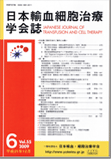All issues

Volume 53 (2007)
- Issue 6 Pages 591-
- Issue 5 Pages 547-
- Issue 4 Pages 463-
- Issue 3 Pages 359-
- Issue 1 Pages 17-
Volume 53, Issue 4
Displaying 1-4 of 4 articles from this issue
- |<
- <
- 1
- >
- >|
Originals
-
Miho Okutsu, Syunichi Saito, Satoshi Ono, Yuko Obata, Kazuya Watanabe, ...2007Volume 53Issue 4 Pages 463-466
Published: August 27, 2007
Released on J-STAGE: October 31, 2008
JOURNAL FREE ACCESSWe compared the albumin-enhanced indirect antiglobulin test (Alb-IAT) and polyethylene glycol-enhanced IAT (PEG-IAT) for their detection rate and specificity of irregular antibodies, and the frequency of delayed hemolytic transfusion reactions (DHTR).
Screening and identification for irregular antibodies were performed using Alb-IAT in 25,947 patients from 1990 to 1996 and PEG-IAT for 23,039 patients from 1997 to 2003. The rates of irregular antibodies detected by the two methods were not statistically different, at 1.07% for Alb-IAT and 1.16% for PEG-IAT. In contrast, the rates of detection of anti-E and anti-Jka by PEG-IAT was significantly higher than that by Alb-IAT (p<0.05), whereas the rate for anti-Leb was lower (p<0.01). The frequency of DHTR was not statistically different during the use of between Alb-IAT (10 cases, 0.24%) and PEG-IAT (6 cases, 0.13%).
PEG-IAT was more sensitive than Alb-IAT in detecting clinically significant antibodies such as anti-Rh and anti-Kidd. However, no significant decrease in DHTR in transfusion recipients was observed.View full abstractDownload PDF (278K) -
A SENSITIVE CHEMILUMINESCENCE ENZYME IMMUNOASSAY FOR DONOR SCREENING OF HUMAN PARVOVIRUS B19 ANTIGENHiromi Takeda, Hidekatsu Sakata, Keiji Matsubayashi, Naohito Sakagami, ...2007Volume 53Issue 4 Pages 467-472
Published: August 27, 2007
Released on J-STAGE: October 31, 2008
JOURNAL FREE ACCESSTo prevent the risk of human parvovirus B19 (B19) transmission through contaminated blood products, Japan Red Cross Blood Center has introduced a B19 screening with receptor-mediated hemagglutination assay (RHA), and the contamination level of B19 in the plasma pool has significantly decreased. However the detection limit of RHA (1010 IU/mL) is not sufficient to satisfy the FDA requirement of less than 104 IU/mL in the plasma pool. Here, we developed a new sensitive chemiluminescence enzyme immunoassay for screening B19, CLEIA-B19 Ag. Results of CLEIA-B19 Ag assay with B19 DNA-positive samples (n=152) showed that the sensitivity of CLEIA-B19 Ag was about 4 logs greater than that of RHA. Of 671 samples that were negative by 20-pooled NAT, one sample was CLEIA-B19 Ag-positive but B19-DNA-negative (false positive). In conclusion, CLEIA-B19 Ag is highly sensitive B19 assay with few nonspecific reactions, and should therefore be useful for B19 blood screening.View full abstractDownload PDF (440K)
Report
-
Koji Matsuzaki2007Volume 53Issue 4 Pages 473-476
Published: August 27, 2007
Released on J-STAGE: October 31, 2008
JOURNAL FREE ACCESSWe investigated by questionnaire the present status of blood products in hospitals in Ehime Prefecture during last year (2005). Our investigation covered 66.7% of all RCC (Red Cell concentrates) supplied during the year in the prefecture. Results showed that RCC accounts for a major proportion of discarded blood products in hospitals. Among large-scale hospitals having 500 or more beds, 26,414 units of RCC were purchased, of which 632 units were discarded, giving a discarded ratio of 2.4%. Among mid-scale hospitals having 200∼499 beds, 13,041 units were purchased, of which 783 were discarded, giving a ratio of 6.0%, while small-scale hospitals having 199 beds or less purchased 7,607 units and discarded 753 for a ratio of 9.9%. These findings suggest that hospitals which purchased larger amounts of RCC should aim at a discard ratio of 1% or less. In contrast, hospitals purchasing comparatively small amounts of RCC presented a wide range of discard ratios. We suspected that the difficulty of reusing unused RCC in mid-or small-scale hospitals affects the discard ratio of RCC, as well as transfusion management methods. We consider that a new reuse system for unused RCC for mid- and small-scale hospitals is required.View full abstractDownload PDF (338K)
Secondary Publication
-
SIMULTANEOUS FIVE CELL-LINEAGE FLOW CYTOMETRIC ANALYSIS SYSTEM FOR DETECTION OF LEUCOCYTE ANTIBODIESNobuki Matsuyama, Yoshitaka Kojima, Fumiya Hirayama, Kazuta Yasui, Ats ...2007Volume 53Issue 4 Pages 477-484
Published: August 27, 2007
Released on J-STAGE: October 31, 2008
JOURNAL FREE ACCESS
- |<
- <
- 1
- >
- >|